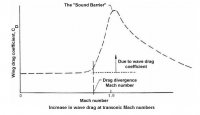gtranquilla
RadioActive
Some time ago I noticed on this forum that someone had indicated propeller speeds must be kept below 80% of the speed of sound.
It reminded me of something I read some time ago on this topic. Today I found that info and thought it would be good to post it here for other who are curious.
Turns out the original comment is 100% correct and for good reason..... see below.
View attachment 11976
http://www.aerospaceweb.org/question/aerodynamics/q0104.shtml
Propeller drag generally increases in a linear fashion as the speed increased due to aerodynamic drag.
But suddenly it increases exponentially when it gets to 80% of the speed of sound.
This not due to aerodynamic drag but due to other factors as explained in the hotlink above.
The speed on the prop is always fastest at the tip and the larger the prop radius easier it is to get the tips to reach the sound barrier, if the motors can provide the torque and speed to do it.
So in general, larger diameter propellers need to be driven by higher torque but slower speed motors, i.e., motors with more poles. :dejection:
It reminded me of something I read some time ago on this topic. Today I found that info and thought it would be good to post it here for other who are curious.
Turns out the original comment is 100% correct and for good reason..... see below.
View attachment 11976
http://www.aerospaceweb.org/question/aerodynamics/q0104.shtml
Propeller drag generally increases in a linear fashion as the speed increased due to aerodynamic drag.
But suddenly it increases exponentially when it gets to 80% of the speed of sound.
This not due to aerodynamic drag but due to other factors as explained in the hotlink above.
The speed on the prop is always fastest at the tip and the larger the prop radius easier it is to get the tips to reach the sound barrier, if the motors can provide the torque and speed to do it.
So in general, larger diameter propellers need to be driven by higher torque but slower speed motors, i.e., motors with more poles. :dejection:

